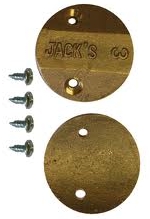Not entirely a thing of the past, toe weights are definitely less common than they used to be. A common thought when applying toe weights is to get the horse to "reach more." This implies producing a longer stride.
Another reason is to help stabilize the gait of a trotter through the additional weight, although this is typically done with heavier shoes or bell boots. I almost never see horses wearing all three anymore (toe weights, heavy shoes, and bell boots). The reason being is that if a trotter needs all three added weight elements to stay on gait, it will probably not compete at a high level.
While it is true that increased weight exaggerates motion, the cost of that added motion is fatigue. Fatigue is due to the increased energy required to put that weight into motion. Horses with heavier shoeing packages work harder than those shod light; it is as simple as that. There is no better support to this point than the fact that so many trainers elect to race barefooted in big races, especially in second-heat races. A few special horses gait better with added weight and overcome the fatigue factor to win. Donato Hanover was a great example of this.
With the idea that added weight increases animation, it is logical to assume that a toe weight on the front of the hoof wall will cause that hoof to flip up more dramatically as it transitions into the landing profile within each stride. The benefit here might be to get a short-striding horse into a better landing position, thus producing an improved gait. Whether or not this begets a longer stride is still very much up for debate in my opinion.

 (Photo by the author) According to the author, toe weights come in two different styles and are easy to apply to the hoof.
(Photo by the author) According to the author, toe weights come in two different styles and are easy to apply to the hoof.
Horses have the longest stride when they are the most sound. Lameness is the main reason horses get short-strided and sore feet are very much a culprit. A shoeing and weight package to make the horse stride longer is one that keeps the horse most comfortable. Support of the limb, proper traction, protection and weight are all factors in this. Adding weight to an already sore racehorse will eventually have a negative impact on performance.
So, if you have determined that your horse is relatively sound and benefits from a little additional weight, putting on a pair of toe weights is an easy thing to do. Any farrier can apply them.
Two tips: First, keep the screws as short as possible, 5/8-inch or less, No. 8 screws. If too long, screws can damage the structures lying beneath the hoof wall causing an abscess. Or, in extreme circumstances, it could damage the laminae which attach the coffin bone to the hoof wall.
Second, add silicone to the back of the weight before placing it on the hoof. This will create a seal between the metal and the hoof wall and keep dirt out. It also prevents the toe weight from moving, which might work the screws loose. When you tighten the two screws down, the silicone will squeeze out around the sides; tidy that up with your finger and it is sealed. As with any type of adhesive, both surfaces need to be clean and dry.
Toe weights affect different horses in different ways and not always for the better according to trainer-driver Dan Shetler. This is easy to believe given the fact that horses vary so greatly in gait and lower limb conformation. Sometimes a little weight just gives a young trotter a bit more confidence in its stride. One thing for certain is that the evolution of the breed (and possibly the trotting hobble) has reduced the use of toe weights. I used to put on toe weights regularly. Now I don't put on 10 pairs in a year. If your horse is one who truly benefits and races better with toe weights (and some still exist), it is decided by experimenting with them. Always remember they are just as easy to take off as they are to put on.
Toe weights are still available in 2-4-oz. sizes though I haven't seen anything heavier than 2 ounces on a horse for a long time now. They are available and in two different styles. Given the speed of today's racehorses my only suggestion when considering these devices is to weigh your options carefully.
Veteran Standardbred farrier Steve Stanley of Lexington, Ky., authors a monthly column for Hoof Beats, the official harness racing publication of the U.S. Trotting Association. The American Farriers Journal Editorial Advisory Board member offers plenty of practical advice that will be of special interest regardless of the type of horses that you work with. Click here to read more from Steve Stanley's Hoof Beats series.







Post a comment
Report Abusive Comment